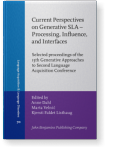Part of
Current Perspectives on Generative SLA - Processing, Influence, and Interfaces: Selected proceedings of the 16th Generative Approaches to Second Language Acquisition ConferenceEdited by Marta Velnić, Anne Dahl and Kjersti Faldet Listhaug
[Language Acquisition and Language Disorders 70] 2024
► pp. 1–8
